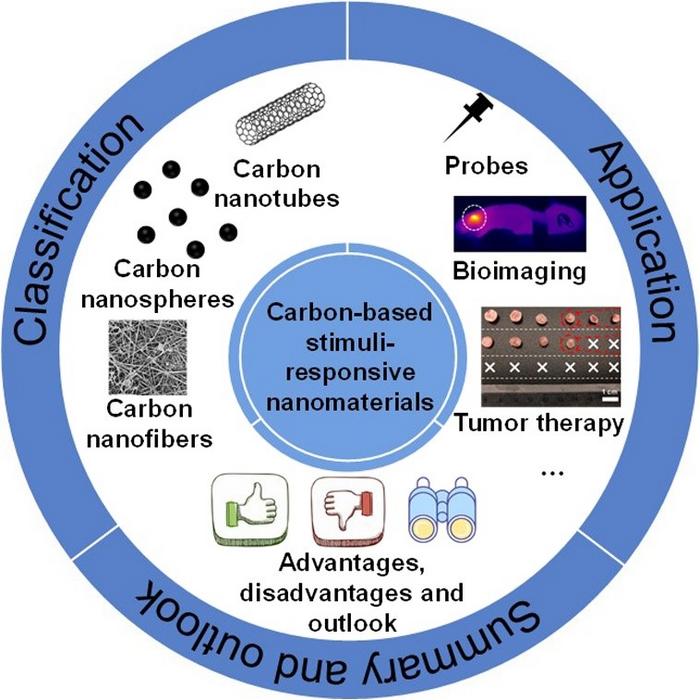Carbon-based stimuli-responsive nanomaterials are gaining much attention due to their versatility, including disease diagnosis and treatment. They work under endogenous (pH, temperature, enzyme, and redox) or exogenous (temperature, light, magnetic field, ultrasound) stimuli. Carbon-based stimuli-responsive nanomaterials can be used as smart materials with dynamically tunable physicochemical properties in response to changes in internal or external environmental stimuli. Their diverse combinations of nanostructures and molecular designs, as well as functional complexes with different carriers, create new opportunities for the development of advanced smart nanomaterials.
A research team from the Beijing Institute of Technology review the classification and application of carbon-based stimuli-responsive nanomaterials, based on their microstructures and properties, and discuss the applications of carbon-based stimuli-responsive nanomaterials in probes, bioimaging, tumor therapy, and other fields. Finally, they analyze and summarize the advantages and disadvantages of carbon-based stimuli-responsive nanomaterials and provide an outlook on their application prospects.
They published their recommendations in Cyborg and Bionic Systems, on Mar 9.
The authors classify carbon-based nanomaterials into 3 main categories: carbon nanotubes, carbon nanospheres, and carbon nanofibers. At the same time, several carbon-based stimuli-responsive nanomaterials involved in the research at the frontier of science and engineering are listed, and more specific differences are reflected in the synthesis and preparation methods of various carbon nanomaterials.
Then, the authors list the applications of carbon-based stimuli-responsive materials in the field of probes, bioimaging, and tumor therapy. Carbon-based nanomaterials are used in anti-counterfeiting and optical imaging applications due to their unique optical properties. Conjugation with different targeted detection reagents can increase the sensitivity of carbon-based nanomaterials. Carbon-based nanomaterials can also be used as drug delivery carriers or therapeutic reagents (photothermal, photodynamic, chemotherapy, etc.) for disease treatment.
Finally, the authors discuss the limitations of the development of carbon-based stimuli-responsive materials and the future perspective. Carbon-based stimuli-responsive materials not only have excellent physical and chemical properties, but also can be combined with other polymers for functionalization, and become excellent carriers for drug delivery and cancer treatment. At present, the safety of carbon-based stimuli-responsive materials is unknown because of the lack of key evidence in medical clinical experiments. To better reduce the controversy of carbon-based stimuli-responsive materials and increase credibility, it is necessary to conduct in-depth research on toxicology, pathology, and biodynamics.
This review summarizes the classification of carbon-based stimuli-responsive materials and their application in the field of biology and chemistry, and discusses the existing defects and future development of them. In general, many studies have shown that carbon-based stimuli-responsive materials play an important role in the biomedical field through hybridization. However, to better reduce the controversy of them and improve their credibility, it is necessary to conduct in-depth research on toxicology and pathology. In the future, researchers are expected to develop new synthetic methods or create new composite materials to improve the safety of carbon-based stimuli-responsive materials and make them more beneficial to human life.
DOI
10.34133/cbsystems.0022
Article Title
Carbon-Based Stimuli-Responsive Nanomaterials: Classification and Application

















